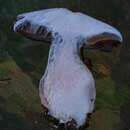fi
nimet breadcrumb-navigoinnissa


Cortinarius cyanites is a basidiomycete fungus of the genus Cortinarius native to Europe.
Elias Magnus Fries described this species in his 1838 book Epicrisis Systematis Mycologici seu Synopsis Hymenomycetum as Cortinarius cyanites.[1] The species name is derived from the Ancient Greek cyanos "dark blue"[2] Within the large genus Cortinarius, it is classified in the subgenus Phlegmacium and section Cyanites. Genetic analysis showed in 2014 that two previously-described species—C. subcyanites and C. pseudocyanites—lay within the concept of C. cyanites, but conversely revealed three distinct lineages, with two new species—C. boreicyanites and C. violaceorubens—described.[3]
The fruitbodies of this fungus have convex caps, with diameters typically in the range 5 to 12 cm (2.0 to 4.7 in), and various shades of violet, brown or grey. They are slimy when young, and later have brown scales. The pale purple stipe is bulbous, 9–15 cm (3.5–5.9 in) in height and 2–3.5 cm (0.79–1.38 in) in width. The flesh is purple, but turns blood red when bruised or cut.[4] The gills on the cap underside have an adnate attachment to the stipe and purple color;[4] later, the deepens to rusty brown as the spores mature.[2] The smell has been described as pleasant and fruity.[3] The lemon-shaped spores measure 8–11.5 by 5–6.5 µm.[4] C. boreicyanites and C. violaceorubens have smaller and larger spores respectively.[3] C. violaceorubens has a dark purple-brown cap, while that of C. boreicyanites is more bluish.[3]
Cortinarius cyanites is found in mixed coniferous and deciduous forests in southern Finland, central Sweden southwards into France.[3]
Cortinarius cyanites is not edible.[4]
Cortinarius cyanites is a basidiomycete fungus of the genus Cortinarius native to Europe.
Elias Magnus Fries described this species in his 1838 book Epicrisis Systematis Mycologici seu Synopsis Hymenomycetum as Cortinarius cyanites. The species name is derived from the Ancient Greek cyanos "dark blue" Within the large genus Cortinarius, it is classified in the subgenus Phlegmacium and section Cyanites. Genetic analysis showed in 2014 that two previously-described species—C. subcyanites and C. pseudocyanites—lay within the concept of C. cyanites, but conversely revealed three distinct lineages, with two new species—C. boreicyanites and C. violaceorubens—described.
The fruitbodies of this fungus have convex caps, with diameters typically in the range 5 to 12 cm (2.0 to 4.7 in), and various shades of violet, brown or grey. They are slimy when young, and later have brown scales. The pale purple stipe is bulbous, 9–15 cm (3.5–5.9 in) in height and 2–3.5 cm (0.79–1.38 in) in width. The flesh is purple, but turns blood red when bruised or cut. The gills on the cap underside have an adnate attachment to the stipe and purple color; later, the deepens to rusty brown as the spores mature. The smell has been described as pleasant and fruity. The lemon-shaped spores measure 8–11.5 by 5–6.5 µm. C. boreicyanites and C. violaceorubens have smaller and larger spores respectively. C. violaceorubens has a dark purple-brown cap, while that of C. boreicyanites is more bluish.
Cortinarius cyanites is found in mixed coniferous and deciduous forests in southern Finland, central Sweden southwards into France.
Cortinarius cyanites is not edible.
Capel fin a 10 cm, fibrilos, sech o sliss, gris viòla peui brun grisastr bleu. Bòrd pì o meno velà. Lamele bluastre. Gamba àuta fin a 10 cm e larga fin a 2 o 4 cm, ch'a anrossiss a fërtela. Carn bleuva, reusa-ross al taj. Odor bon.
A chërs sota latifeuje e conìfere, a l'ha pì car la montagna.
![]() A venta mai mangé un bolè trovà se un a l'é nen un bon conossidor dij bolè!
A venta mai mangé un bolè trovà se un a l'é nen un bon conossidor dij bolè!
Sensa anteresse alimentar.
Cortinarius cyanites Fries
Capel fin a 10 cm, fibrilos, sech o sliss, gris viòla peui brun grisastr bleu. Bòrd pì o meno velà. Lamele bluastre. Gamba àuta fin a 10 cm e larga fin a 2 o 4 cm, ch'a anrossiss a fërtela. Carn bleuva, reusa-ross al taj. Odor bon.
AmbientA chërs sota latifeuje e conìfere, a l'ha pì car la montagna.
Comestibilità![]() A venta mai mangé un bolè trovà se un a l'é nen un bon conossidor dij bolè!
A venta mai mangé un bolè trovà se un a l'é nen un bon conossidor dij bolè!
Sensa anteresse alimentar.
Zasłonak oliwkowobłękitny (Cortinarius cyanites Fr.) – gatunek grzybów należący do rodziny zasłonakowatych (Cortinariaceae)[1]
Pozycja w klasyfikacji według Index Fungorum: Cortinarius, Cortinariaceae, Agaricales, Agaricomycetidae, Agaricomycetes, Agaricomycotina, Basidiomycota, Fungi[1].
Nazwę polską podał Andrzej Nespiak w 1981 r[2]. Niektóre synonimy naukowe[3]:
Średnica 4-9 cm, kształt u młodych owocników półkulisty, później łukowaty, w końcu rozpostarty. Posiada niewielki, tępy garb. Brzeg kapelusza podwinięty, u młodych owocników połączony z trzonem białą osłona. Powierzchnia pilśniowa lub włóknisto-łuskowata, u młodych owocników niebieskoszara lub niebieskofioletowa, u starszych ma kolor od ochrowego do czerwonobrązowego. Podczas wilgotnej pogody jest kleisty[4].
Wąskie iwąsko przyrośnięte do trzonu, za młodu ciemnoniebieskie, później brązowofioletowe[4].
Wysokość 4-8 cm, grubość 1,5-3 cm, kształt od maczugowatego do cebulowato bulwiastego. Jest pełny i kruchy. Powierzchnia różowofioletowa lub (rzadziej) czerwonawobrązowa, pokryta drobnymi, brązowymi łuseczkami[4].
Gruby, jasnofioletowy. Uszkodzony bardzo szybko zmienia barwę na winnoczerwoną. Smak gorzki, zapach słaby, delikatny[4].
Rdzawobrązowe. Zarodniki kształtu cytryny, o rozmiarach 8.8-11,5 × 8.8-11.5-6.5 μm[5].
Występuje w Ameryce Północnej i w Europie[5]. W Polsce gatunek rzadki. Znajduje się na Czerwonej liście roślin i grzybów Polski. Ma status V – gatunek, który zapewne w najbliższej przyszłości przesunie się do kategorii wymierających, jeśli nadal będą działać czynniki zagrożenia[6]. Znajduje się na listach gatunków zagrożonych także w Danii, Niemczech i Anglii[2].
Rośnie w górskich lasach iglastych i liściastych, na glebach o dużej zawartości próchnicy[4].
Grzyb trujący[4]. Żyje w mikoryzie z drzewami[2].
Jest wiele gatunków zasłonaków o niebieskawej barwie blaszek i trzonu, ale tylko u zasłonaka oliwkowobłękitnego jasnofioletowy miąższ po rozkrojeniu zaraz zmienia barwę na winnoczerwoną[4].
Zasłonak oliwkowobłękitny (Cortinarius cyanites Fr.) – gatunek grzybów należący do rodziny zasłonakowatych (Cortinariaceae)